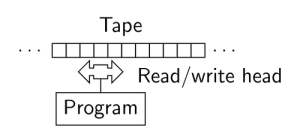bigsmartdata | From the Poised Realm, the embodiment of Trans-Turing Systems, as a real invention, doth flow. Of course you are familiar with the Turing Machine: the theoretical paper tape compute engine to which all modern processors are obliged to worship every Sunday…you are, of course, familiar with the Turing Machine.

The Turing Machine
The work of Alan Turing is the rock from which the quest for a congruent theoretical computer science was launched. Totally awesome quantum computing heavy Scott Aaronson has written that when it comes to AI, we can divide everything that’s been said about it into two categories: the 70% that was covered in Turing’s 1950 paper Computing Machinery and Intelligence, and the remaining 30% that has followed in the decades since then.
Turing Machine = Foundation of Computer Science
So whoa — a Trans-Turing System? What?? I must know more!
That was the third thing that drove me to Tucson. I had to ask Kauffman what he meant — what he Tsaw, what he imagined. I found a description in the patent that Kauffman, et al, filed in 2014:
58"Further disclosed herein is a Trans-Turing machine that includes a plurality of nodes, each node comprising at least one quantum degree of freedom that is coupled to at least one quantum degree of freedom in another node and at least one classical degree of freedom that is coupled to at least one classical degree of freedom in another node, wherein the nodes are configured such that the quantum degrees of freedom decohere to classicity and thereby alter the classical degrees of freedom, which then alter the decoherence rate of remaining quantum degrees of freedom; at least one input signal generator configured to produce an input signal that recoheres classical degrees of freedom to quantum degrees of freedom; and a detector configured to receive quantum or classical output signals from the nodes."
Sweet. I got it. Quantum computing nodes working in tandem with classical compute (Turing Machine) systems and what emerges is a Trans-Turing Machine, not constrained nor otherwise entailed by a bothersome set of NP-complete limits. Polynomial hierarchy collapse ensues, at long last P = NP, and we are full throttle to ride warp drive engines to the stars! Maybe? Maybe. Maybe not.
I had to ask Kauffman.
After I spotted him at the outdoor mixer on Thursday night, after I got over my fanboy flutters, after I introduced myself, chatted with him for a bit about his new book and how much I liked it, after I explained my own thoughts from my field in computer science, and how his book from a decade and a half earlier had so deeply influenced me, I did finally ask.
“So how do we build the Trans-Turnig Machine?”
A wry smile crossed his face. His eyes lit. For a moment he stopped being the intellectual giant I had come to revere, and revealed the mischievous, inquisitive, childlike spirit that must have driven him his entire life.
“I have no idea,” he said replied with a grin.
I was all satisfied. I knew he did not mean that he could not conceive of one, nor he did mean that he could not describe one, nor not define the attributes it might require, nor not imagine how it might function. What he meant was we still don’t know enough about quantum computing to imbue an instrument of our own creation with something akin to consciousness — whatever that means.
Today we all harvest the ample fruits from the first baby steps into the Network Age. We are still painting a digital patina over the planet. More stuff soon will think. We are clearly well into the age of pervasive computing, but computing is not yet ubiquitous, though soon it will be. Soon — within a decade — everything will be engineered to connect with everything, and almost all those systems are and will be awesome Turing Machines, programmable systems all, that will link us all together in a transcendent fine-grained meshed digital fabric of increasing value. Yet on the fringes, there is quantum computing, playfully peeking through from behind the classical physics curtain. And therein lies the unpredictable. It could be that Here There Be Monsters. Or not. That’s the beauty and the bizarre of where we are. Both terror and elation are on the rise, though neither are as appropriate nor as compelling as is the raw, robust curiosity that drives us ever forward.
Is the ineffable thing to come a D-Wave progeny? Maybe. Will Scott Aaronson explain and extend the exploding adjacent possible? Probably. Did Kauffman and Hameroff lead us to the brink? Absolutely. And from the wily Trans-Turing Machine, will Machine Consciousness one day emerge … whatever that means?
I have no idea.


0 comments:
Post a Comment